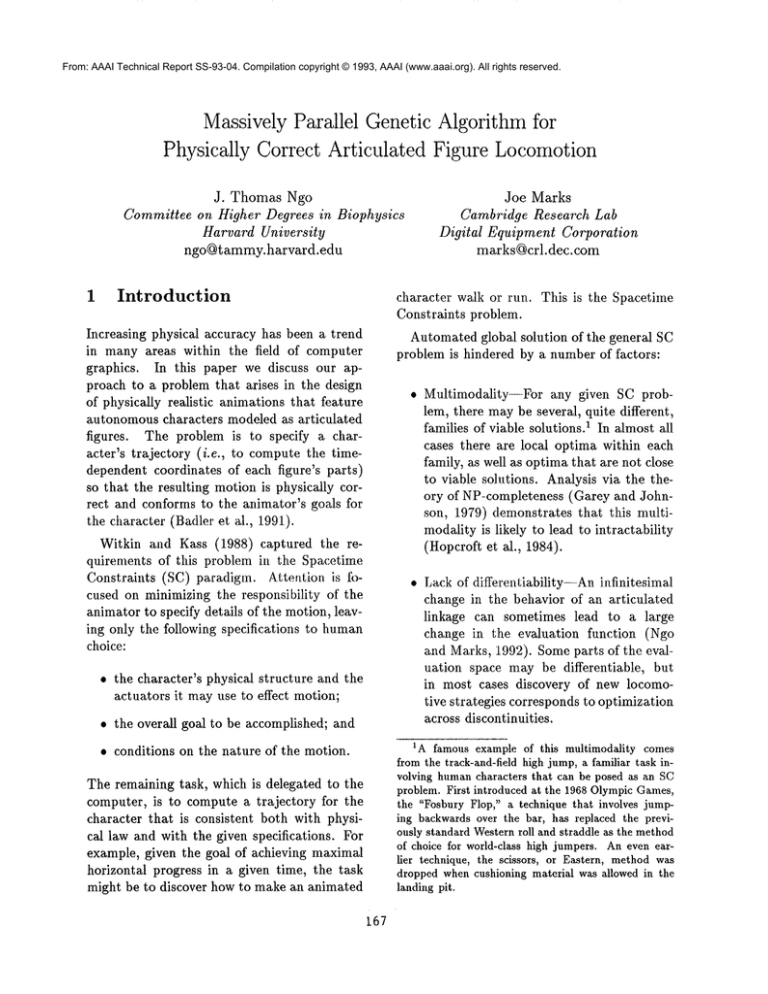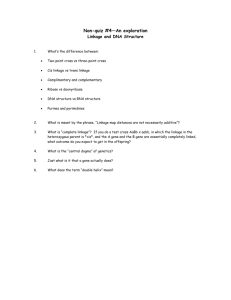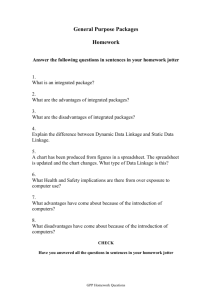
From: AAAI Technical Report SS-93-04. Compilation copyright © 1993, AAAI (www.aaai.org). All rights reserved.
MassivelyParallel GeneticAlgorithmfor
Physically CorrectArticulated Figure Locomotion
J. Thomas Ngo
Committee on Higher Degrees in Biophysics
Harvard University
ngo@tammy.harvard.edu
1
Introduction
Joe Marks
Cambridge Research Lab
Digital Equipment Corporation
marks@crl.dec.com
character walk or run. This is the Spacetime
Constraints problem.
Increasing physical accuracy has been a trend
in many areas within the field of computer
graphics. In this paper we discuss our approach to a problem that arises in the design
of physically realistic animations that feature
autonomous characters modeled as articulated
figures. The problem is to specify a character’s trajectory (i.e., to compute the timedependent coordinates of each figure’s parts)
so that the resulting motion is physically correct and conforms to the animator’s goals for
the character (Badler et al., 1991).
Automatedglobal solution of the general SC
problem is hindered by a number of factors:
Witkin and Kass (1988) captured the requirements of this problem in the Spacetime
Constraints (SC) paradigm. Attention is focused on minimizing the responsibility of the
animator to specify details of the motion, leaving only the following specifications to human
choice:
¯ the character’s physical structure and the
actuators it mayuse to effect motion;
¯ the overall goal to be accomplished; and
¯ conditions on the nature of the motion.
The remaining task, which is delegated to the
computer, is to compute a trajectory for the
character that is consistent both with physical law and with the given specifications. For
example, given the goal of achieving maximal
horizontal progress in a given time, the task
might be to discover how to make an animated
167
Multimodality--For any given SC problem, there maybe several, quite different,
families of viable solutions. 1 In almost all
cases there are local optima within each
family, as well as optima that are not close
to viable solutions. Analysis via the theory of NP-completeness (Garey and Johnson, 1979) demonstrates that this multimodality is likely to lead to intractability
(Hopcroft et al., 1984).
Lack of differentiability--An infinitesimal
change in the behavior of an articulated
linkage can sometimes lead to a large
change in the evaluation function (Ngo
and Marks, 1992). Someparts of the evaluation space may be differentiabte,
but
in most cases discovery of new locomotive strategies corresponds to optimization
across discontinuities.
1A famous example of this multimodality
comes
from the track-and-field high jump, a familiar task involving human characters that can be posed as an SC
problem. First introduced at the 1968 Olympic Games,
the "Fosbury Flop," a technique that involves jumping backwards over the bar, has replaced the previously standard Western roll and straddle as the method
of choice for world-class high jumpers. An even earliar technique, the scissors, or Eastern, method was
dropped when cushioning material was allowed in the
landing pit.
Stiffness--The
amount of CPU time required to evaluate a single candidate solution has a low theoretical complexity,
but is large in absolute terms. This is
because the equations of motion are stiff:
accurate simulation must be done on a
fine timescale, whereas interesting behavior occurs on a longer timescale.
GAs are attractive
prospects for the SC
problem for a variety of reasons (Holland,
1975). While not typically the fastest solutions to a given problem, GAs are sometimes
the most robust because they cope well with
multimodality. They do not require gradient
information, and are therefore not limited by
evaluation-space discontinuities encountered in
SC problems. Finally, they appear well suited
for implementation on parallel hardware.
The informal statement of the SC problem
given above is very general. To develop useful
Mgorithms, we must consider restricted, more
specific versions of the problem. Wehave considered a form of the SC problem that contains
a numberof simplifications:
The principal challenge in designing a GA
for use in a particular problem domainis to select an appropriate underlying representation.
Although considerable effort has been spent on
attempts to develop a universal, bit-based GA,
in manycases practical efficiency is achieved
only if crossover and mutation operators--and
hence the underlying representation--can
be
tailored for a given problem (Davis, 1991).
The system is simulated in two dimensions
only.
The only external object is the ground,
which must be horizontal.
The need for problem-specific treatment has
been of particular importance in the case of
physically realistic trajectory planning. Timedomain representations are natural for local
optimization (Witkin and Kass, 1988; Brotman and Netravali, 1988) because they lend
themselves to perturbational analysis. However, they appear to be inappropriate for genetic solution of the global SC problem (Ngo
and Marks, 1992).
The initial conditions consist of positional
constraints only and must be specified
fully.
The muscle torques that can be applied
about the hinges in the linkage are not
subject to hard constraints.
(However,
terms in the evaluation function might be
used to restrain excessive torques.)
Wehave developed a representation for the
SC problem that is based loosely on a stimulusresponse model (Skinner, 1938). A choice
of parameters in this representation may be
thought of as defining a hard-wired "brain" for
a linkage; the task of the GAis to breed brains
for linkages of a given structure, selecting for
brain configurations that lead to behavior that
best conforms to the animator’s goals. Details
of our stimulus-response representation are described elsewhere (Ngo and Marks, 1992). Here
we define the essential concepts and illustrate
the representation by describing a simple SC
problem cast in anthropomorphic terms.
Although a much restricted
version of
the general Spacetime Constraints problem,
this statement includes all of the difficulties
listed above. The simplifications incorporated
therein do not necesssarily reflect inherent limitations of our algorithm (for example, the extension to non-zeroinitial velocities is trivial);
rather, we have chosen to provide the most
economical problem description that covers the
SC problem instances we have considered.
2
Algorithm
The form of the representation directly reflects two facts about linkage locomotion:
firstly, that a linkage can affect its absolute
Wehave implemented a parallel genetic algorithm (GA) using the C* language on a Thinking Machines CM-2with 4096 processors.
168
Exl~and
rapidly
~o
oo
/
o>
minimum
velocity of
_
successful jump "---=
Compress
in air
zero velocity
Squat
T
fully
compressed
center-of-mass
height
fully
expanded
Figure 1: Manually constructed
stimulus-response
solution
Figure 2: Structural
properties
of Willy Worm. All three rods are of equal mass. The center
configuration
is labeled with joint-angle
ranges (in degrees). All of the sample configurations
depicted are consistent with these joint-angle ranges.
169
position and orientation only by changing its
internal configuration; and secondly, that most
such changes in shape have consequences that
depend on circumstances in the environment-for example, pushing on the ground can produce upwardacceleration only if the linkage is
touching the ground.
upward and his center of mass is too high
for him to touch the ground, then it is too
late for him to influence the path of his
center of mass. He can, however, increase
the height cleared by contracting.
In constructing this simple example, we have
identified appropriate stimuli (regions of sense
space), actions (internal target configurations
to adopt), and an appropriate mapping from
the set of sense-space regions onto the set of
actions. Our GAperforms these steps automatically for 2D SC problems.
A candidate solution consists of a small set
of stimulus-response pairs. Each pair is a response (a low-level prescription for changing
the linkage’s internal configuration in a continuous manner) and a stimulus function (which
encodes the conditions under which the response should be executed). Each stimulus
function is a scalar function in sense space,
the space spanned by a set of predefined sense
variables. A sense variable, in turn, may be
any real-valued function of the linkage’s physical state: typically, the set includes all internal joint angles, the pressure exerted by each
joint on the ground, and the position and velocity of the center of mass. At each instant in
its lifetime, the linkage chooses from amongits
repertoire of responses based on the values of
the stimulus functions.
3
Our algorithm has solved problems that appear to be beyond the grasp of existing techniques in animation because they have evaluation functions that are multimodal and discontinuous. We have presented detailed results elsewhere (Ngo and Marks, 1992). Here
we describe simple, representative locomotive
strategies for "Willy Worm"(Figure 2), a small
but flexible 3-rod linkage that was designed for
richness of behavior. In this problem, Willy
is initially at rest in a Z-shapedconfiguration
and attempts to movehis center of mass as far
horizontally as possible within a fixed time.
In the following anthropomorphic example,
the task is for a person to jumpas high as possible from a standing position, with jump height
defined to be the maximumheight cleared.
Figure 1 depicts a good stimulus-response solution to this problem. The two sense variables
are a minimalset chosen for the sake of illustration: the vertical position and velocity of
the person’s center of mass. Each of the three
rectangles represents the region over which a
particular stimulus function dominates. Corresponding to each of these regions is an associated response:
GAs cope with multimodality by allocating increasing amounts of processing time to
promising areas of the search space in a gradual manner, rather than by pruning mediocre
solutions immediately. This effect is particularly easy to observe in our variant of the GA
because the individuals in the population are
spread out in fixed locations on an imaginary
two-dimensional torus. Mating can occur only
between individuals that are close together on
the torus, so relatively homogeneouscolonies
of similar solutions tend to form.
¯ Expand--If the person’s center of mass is
low, then expanding rapidly will propel
him into the air.
¯ Squat--If the person’s center of mass is
too high for expansion to generate enough
vertical momentum,he should first squat.
¯ Compress in air--If
Results
the person is moving
170
Different colonies often correspond to qualitatively different locomotive strategies. Figures 3 and 4 illustrate two modesof locomotion
that competed in a single run. The two behaviors, which we call flipping and shuffling, are
B
Reach
Time
Illllllll
A
Pull
Tin~
B
C
Fall
Reach
Tin’~
Tir~
g’
CD
C’
Pull
Fall
Timo
Tirno
=3
C’D’
D~Reach
Tin~
|Illllllll|
|IIIIIIIIII
D’
Figure 3: Willy Worm
walking forward by flipping.
A~B
Touch
Flop
~
C
Tim~
Time
BC
B’
~
Leap
Time
-
Ill
CD
D
Pull
~
Time
IIIII
C" D"
Flop
Time
Ill
B"C"
~~
Leap
Time
C"D"
Figure 4: Willy Worm
walking forward by shuffling. The full trajectory contains six short cycles
similar to B-C-D-W;
for clarity we depict only the first andthe last.
171
quite different from each other. 2 In principle,
the large population size (4096) is capable
accommodatingrich diversity, but because our
current facilities permit recording and viewing
of only the best trajectory in a given generation, we can see only the tip of the iceberg.
Nonetheless, it is commonfor half a dozen distinct behaviors to be found among the solutions recorded in a single run.
4
of the time.
Only local communication between processors is necessary, obviating the need
for expensive global communicationin the
processor network.
The simple and elegant mapping of the
GAparadigm onto the CM-2architecture
makes for easy development and debugging.
Discussion
Our algorithm computes original and effective
solutions to the restricted SC problems we have
considered so far. The need for expertise on
the part of the user has been eliminated from
nearly every facet of the algorithm. In particular, the user need not be able to construct a
coarse first guess at the form of the trajectory.
To the best of our knowledge, our algorithm is
unique in this respect. But is the success of
the algorithm due to massive parallelism, or in
spite of it?
Thus we concluded that the CM-2could probably provide, in a cost-effective way, the large
computational resources that our GA would
need to find good solutions, and that the development process would be straightforward.
However, our GAdoes not fit
architecture as well as it might:
the machine
The time required to compute the evaluation function for one generation of
the GA--a process that requires
no
communication--far exceeds the communication overhead that is incurred when
solutions are combined through crossover.
Because muchof the dollar cost of a parallel computer like t:he CM-2is invested
in the interprocessor communication network, it would appear that we are not
makingcost-effective use of the architecture.
Some of the key concepts in our approach
are clearly independent of computer architecture. Our two most important choices--using a
stochastic global search strategy in place of the
usual gradient-descent methods (Witkin and
Kass, 1988; Brotman and Netravali, 1988), and
using a stimulus-response representation--had
nothing to do with massive parallelism. These
ideas wouldcarry over directly to a serial variant of our algorithm. The other important
choice we made--the use of a GAas the search
engine--is the one that led us to consider massive parallelism. At first blush, the match between the GAparadigm and current incarnations of SIMDmassive parallelism seems to be
excellent:
A population size of 4096 (one candidate
solution per processor) is required to make
full use of the CM-2,but it is probably too
large for our application. Typical GAsuse
population sizes of 200 or fewer, and the
increased size of our population is at the
expense of additional generations.
¯ With one candidate solution per processor, and almost identical processing required for each solution, it appears possible to keep all the processors busy most
For many other applications,
a steadystate GA outperforms a generationalreplacement
GA on a serial
machine
(Davis, 1991). However, a steady-state
GAcannot be parallelized in a straighforward manner on a SIMD machine.
2Bothbehaviorsare cyclic. Ourrepresentationfosters but is not restricted to cyclicbehavior.
172
In our particular application the evaluation of
candidate solutions turned out to be difficult to
implement efficiently
on a SIMDmachine. To
evaluate the "brain configuration" of a linkage
requires running a physical simulation. Unfortunately, some requirements of the simulation
are incompatible with the CM-2architecture:
Holland, J. It. (1975). Adaptation in Natural
and Artificial Systems. University of Michigan Press.
Hopcroft, J., Joseph, D., and Whitesides,
S. (1984). Movement problems for
dimensional linkages.
SIAM Journal of
Computing, 13(3):610-629.
Ngo, J. T. and Marks, J. (1992). Physically realistic trajectory planning in animation: A
stimulus-response approach. Technical Report 21-92, Center for Research in Computing Technology, Harvard University, Cambridge, MA02138.
Skinner, B. F. (1938). The Behavior of Organisms; An Experimental Analysis. The
Century Psychology Series. D. AppletonCentury, NewYork, London.
Witkin, A. and Kass, M. (1988). Spacetime
constraints. Computer Graphics, 22(4):159168.
¯ The robust simulation of an articulated
figure requires the checking of many special cases. This results in a great amount
of conditionally executed code, and therefore wasted cycles on a SIMDmachine.
¯ The key to efficient physical simulations of
the kind we consider is the use of variablelength time steps. The SIMDarchitecture
essentiMly mandates a uniform time step
for all processors, resulting in slower and
less robust simulations.
Our tentative conclusion is that, on balance,
the CM-2is not the ideal machine for our current application, even though we are delighted
with the results that we have obtained. Weare
optimistic that more current parallel machines
(for example, the CM-5, which has a more
coarse-grained, MIMDarchitecture) may well
address someof the issues that we raise above,
and that o,tr algorithm ma.y benefit from architectural advances by computer manufacturers.
References
Badler, N. I., Barsky, B. A., and Zeltzer, D.,
editors (1991). Making Them Move: Mechanics, Control, and Animation of Articulated Figures. Morgan Kaufmann, San Mateo, CMifornia.
Brotman, L. S. and Netravali, A. N. (1988).
Motion interpolation by optimal control.
Computer Graphics, 22(4):309-315.
Davis, L. (1991). Handbookof Genetic Algorithms. Van Nostrand Reinhold, NewYork.
Garey, M. R. and Johnson, D. S. (1979). Computers and Intractability:
A Guide to the
Theory of NP-Completeness. W. H. Freeman and Company, San Francisco.
173




